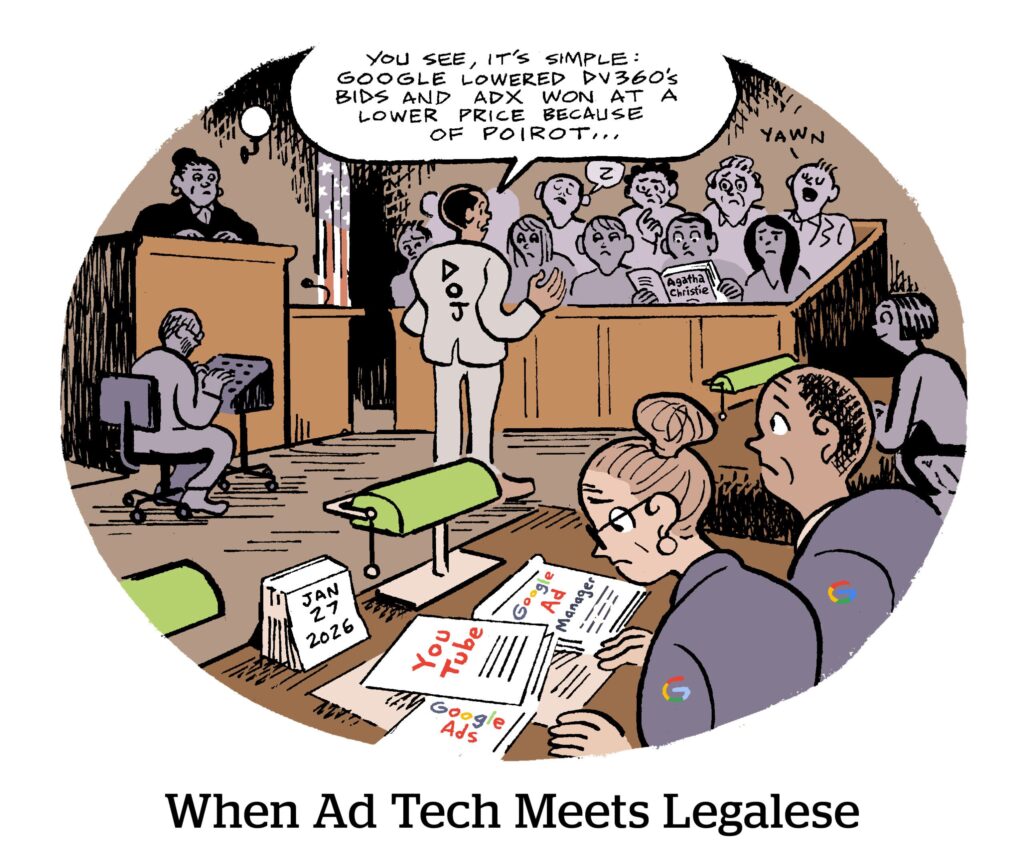Here’s today’s AdExchanger.com news round-up… Want it by email? Sign up here.
Dissing And Dismissing
Quelle surprise.
On Monday, Google filed a motion to dismiss the Justice Department’s antitrust case over Google’s dominance over the online advertising market.
The DOJ sued Google in January alleging that the behemoth – sorry, the company – not only monopolizes digital advertising but has been able to do so “by engaging in a systematic campaign to seize control” over the “high-tech” tools used by publishers and advertisers.
According to Google, the DOJ’s suit defines the ad market too narrowly by excluding some of Google’s biggest competitors, including Meta, Amazon and TikTok, WashPo reports.
The government’s definition of the digital ad market as relating solely to web advertising is, Google argues, also made on shaky ground because app and video advertising are major growth areas for the industry.
Google also notes in its motion that the FTC and DOJ didn’t take issue with its acquisitions of DoubleClick and Admeld at the time, which happened 15 and 12 years ago, respectively.
Will Google be successful in its bid? Who knows. In 2021, a federal judge granted Facebook’s motion to dismiss state and federal antitrust suits seeking to unwind its Instagram and WhatsApp acquisitions. Then the FTC refiled its suit, and a judge ruled last year that the case can proceed.
Like sands through the hourglass, these are the lawsuits of our lives.
Racing Pulse
TV currencies are rushing to snag partnerships with programmers ahead of the upfronts.
On Tuesday, Comscore expanded its 48-hour measurement reporting for local TV viewing, which it calls “Pulse,” to include all 210 local US markets. Until now, it was only reaching 60.
Advertisers can now use Comscore to do in-flight optimization for all local and national US campaigns, Carol Hinnant, Comscore’s CRO, tells AdExchanger.
Now that Pulse spans nationally, buyers can get faster reporting on campaigns running in the 150 US markets that just made the list.
According to Hinnant, access to quicker reporting was one of the deciding factors that led Warner Bros. Discovery (WBD) and Tubi to choose Comscore as a measurement partner.
WBD is an especially big win for Comscore. Although it already used Comscore to transact on advanced audiences, WBD now plans to sell linear inventory against Comscore currency during this year’s upfront for the first time.
No Money, No Funny
Media buyers are unhappy with Netflix’s underperforming ad-supported tier due to its hefty $55 CPM and dearth of subscribers, Digiday reports.
To date, Netflix’s ad-supported tier has around 1 million subs, and advertisers are still getting money back because Netflix isn’t meeting its viewership guarantees.
Advertisers are also less than satisfied with Netflix’s targeting and measurement capabilities.
But Netflix has so much potential that agencies are willing to grit their teeth and see where things go, particularly as the streamer’s new talent bench gets settled. Jeremi Gorman and Peter Naylor, both poached from Snap by Netflix last summer, are building their teams, and sales directors have been pouring in from companies such as Disney, Vevo and Google.
It’s understandable that Netflix’s ad biz launch hasn’t been “exactly perfect from the very beginning,” Matt Kramer, head of brand investment at Media.Monks, tells Digiday.
“As Netflix grows their ad-supported subscriptions,” Kramer says, “that supply and demand will become more equalized, and we will see that reflected in the CPMs.”
But Wait, There’s More!
Ecommerce giant Alibaba is dividing its empire into six business units. [TechCrunch]
The life insurance industry could become one of the first sectors subjected to strict rules around the use of algorithms and models powered by AI as regulators seek to protect consumers from discrimination and bias. [Bloomberg]
Disney starts the first of three rounds of layoffs this week. [CNBC]
Consumers are questioning Levi’s use of AI models to increase diversity in its marketing. [Ad Age]
How Meta is trying to market Reels to advertisers. [release]
You’re Hired!
Tinuiti appoints Jeremy Cornfeldt as its first president. [release]
Adform brings on Joseph Dressler as VP of sales in the US. [release]
















